The Centenary of the Australian War Records Section
History
One hundred years ago, in May 1917, the Australian War Records Section (AWRS) was formed in London. It is from this date that we trace the formal origins of the Australian War Memorial. Over the next two years the AWRS acquired approximately 25,000 objects, as well as paper records, photographs, film, publications, and works of art. All were brought back to Australia in 1919 and formed the basis of the collection of what would eventually become the Australian War Memorial.
The AWRS was set up at the prompting of Charles Bean, Australia’s official war correspondent, soon to be made official historian. It was led by John Treloar, a young army officer who became the Memorial’s inaugural Director. On 16 May 1917, Lieutenant Treloar walked into an obscure office in London and got down to work with a staff of just four. The section's task was to collect and organise the documentary record of the Australian forces, so that it could be preserved for Australia, rather than be absorbed into Britain's records. Bean had been impressed with the work of the Canadians in establishing in London a Canadian War Records Office. And like the Canadians, the Australian section quickly began collecting and commissioning a wide range of material.
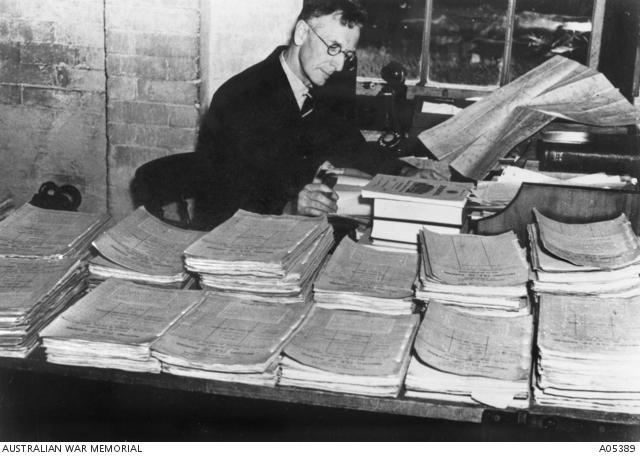
Informal portrait of C E W Bean working on official files in his Victoria Barracks office during the writing of the Official History.
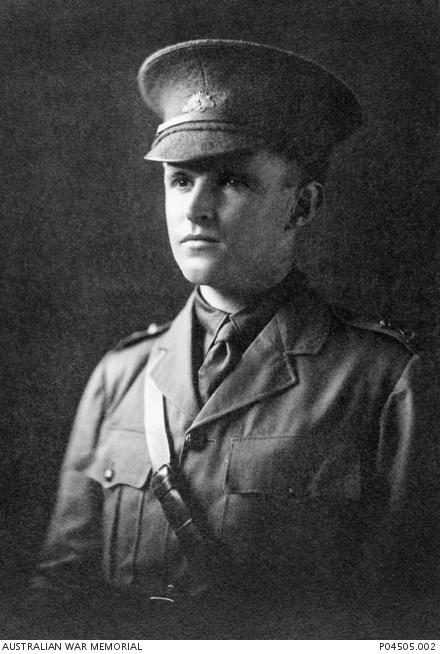
Studio portrait of Lieutenant John Linton Treloar on receiving his commission in the Australian Flying Corps.
The Canadian and Australian governments were aware that a war museum was being formed in Britain and they would on no account allow the British to secure the best Canadian or Australian ‘trophies’ and records for its museum. Bean felt strongly that the records and ‘relics’ (as he called them) that told of Australian achievements and sacrifice should be collected and shipped home to the Australian people.
In 1919, an ‘Australian War Museum’ (later Memorial) was formed in Australia from the collections amassed by the section. In 1920 Treloar was appointed Director, a position he held until his death in 1952. Bean and Treloar worked together during these years to guide the Australian War Memorial into being.
The AWRS is therefore the precursor of the modern Memorial. Based in London, it developed networks of field officers in France and Egypt, and by 1919 was employing over 600 staff, both military and civilian. Through circulars and personal contact, it encouraged soldiers of all ranks to maintain the best possible official records, and to collect and send in the best museum objects. By February 1919, approximately 25,000 objects were waiting to be shipped home. These included not just large objects such as vehicles, heavy weapons, a tank and several aeroplanes, but smaller weapons and equipment, tools, trench signs (including the famous ‘Roo de Kanga’ sign), uniforms, flags, medals and souvenired material. Some objects were distributed to the Australian states in the immediate post-war years; the rest were retained by the Memorial.
It is on the basis of the AWRS collection, and the vision and dedication of the people behind it, that the Memorial has become more than just a monument. It is an expression of a unique idea: that people should come to the Memorial to learn and to understand, as well as to reflect and to remember. The Memorial's building in Canberra opened in 1941 and has become one of the world's great museums, holding a collection of historic material that documents and interprets the Australian experience of war. Its different facets - the commemorative area, galleries, grounds, Research Centre and digital channels - work together to fulfil the Memorial's purpose.
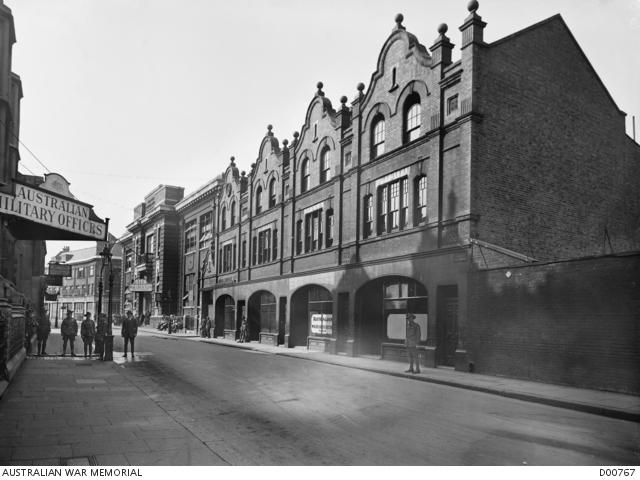
From March 1918 onwards, this building, in Horseferry road, London, contained the main offices and darkrooms of the AWRS. It was immediately opposite AIF [Administrative] Headquarters.
One of the most fundamental military historical records were the monthly war diaries kept by each unit. Collecting and organising these was the AWRS’s first responsibility. For easy access, war diaries were bound by the AWRS in London. They remained in their covers until the 1980s, when they were unbound in preparation for microfilming. The war diaries have been digitised for yet another generation of users. A sampling of the old covers has been kept by the Memorial. This photograph show the improvement made after a concerted campaign by the AWRS to improve the quality of diaries. The first stack shows a month’s worth of diaries from 1916, the second stack shows those from a similar period in 1918.
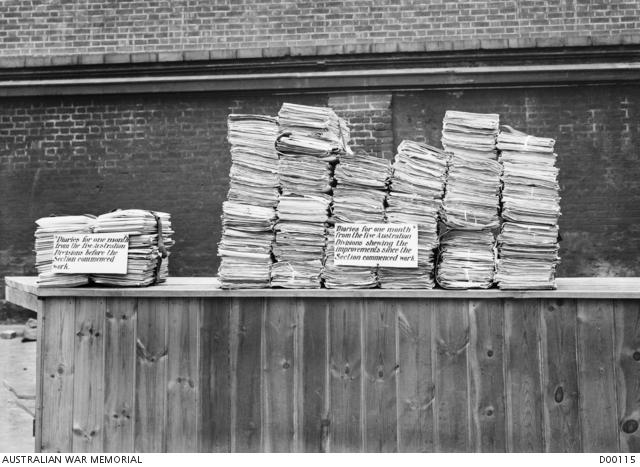
Two stacks showing the comparison between the number of war diaries in bundles, submitted for one month by units of the five Australian Divisions, before, and after the establishment of the Australian War Records Section.
Casualty
Throughout its years of operation, the AWRS suffered only one operational casualty - Corporal Ernest Lionel Bailey, whose story will be read at the Last Post ceremony commemorating the centenary on Tuesday 16 May 2017. He enlisted in the Australian Imperial Force in August 1915 and in September 1917 was promoted to lance corporal and detached for duty to the AWRS.
Bailey earned a promotion to corporal the following year and in May 1918 he was working on some collected items that needed to be put in storage. There were some German trench mortar bombs which still contained some high explosive. Bailey was removing the explosive residue with a chisel after soaking the bombs in water for two days, as was the practice at the time. At about 2.30 in the afternoon, an explosion went off and killed Bailey outright. Charles Bean later wrote, “He was a splendid man, keen and intensely trustworthy. More than any man I know he was responsible for the founding of this Australian War Museum with such a splendid series of exhibits… he will not be replaced – they will not get another man like him. The thought of his cheery smile as he came on the coldest days of the winter… makes one sick at heart for the loss of him.”
Bean paid Bailey a great tribute when he said, “the great Australian War Museum, when it finally stands in the Australian capital, will be a monument to him; for it is his work that thousands upon thousands of Australians will see as they walk down those galleries.” Corporal Ernest Lionel Bailey was buried in the nearby Vignacourt British Cemetery. He was 32 years old.
100 years on
A century on, the significance of first hand records - which provide a personal perspective on the Australian experience of war - is as important as it was at our inception.
The Memorial urges contemporary ADF personnel to create records of your service, maintain and preserve them with a view of one day handing them over to the Australian War Memorial so your story can be told. This will enable us to continue guarding the record and interpreting Australia’s military history for many years to come. Visit our donations page for more information on donating records.
Commemorative activities
The Memorial has a program of exhibitions planned to commemorate the centenary including:
A Good Little Chap
In late 1916 Charles Bean was joined on the Western Front by British press photographer Herbert Baldwin. As the first official photographer and cinematographer appointed to the Australian Imperial Force, Baldwin was tasked with recording the movements and actions of Australian soldiers. Find out more information on A good little chap.
To Heal The Nation
In the aftermath of the First World War, official war correspondent Charles Bean worked tirelessly to establish a memorial to the thousands of Australians who had lost their lives on the battlefields. Discover how Bean’s experiences shaped his vision for the Australian War Memorial. Learn more about To Heal the Nation exhibition.
Art of Nation: Australia's official art and photography of the First World War
In 1919 Charles Bean made a sketch that depicted his vision for Australia’s “war memorial museum”. Partnered with Ortelia Interactive Spaces, the Memorial presents Bean’s original concept online as a navigable 3D environment that incorporates more than 400 mapped images of the First World War. Learn more about Art of Nation.
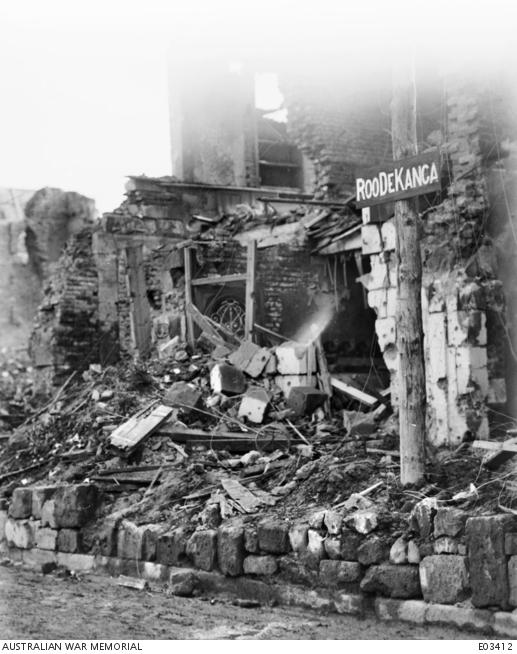
A sign which reads "Roo de Kanga", a characteristic example of Australian street nomenclature, in Peronne, a month after its capture by the Australian troops. Note the shell damaged buildings in the background.
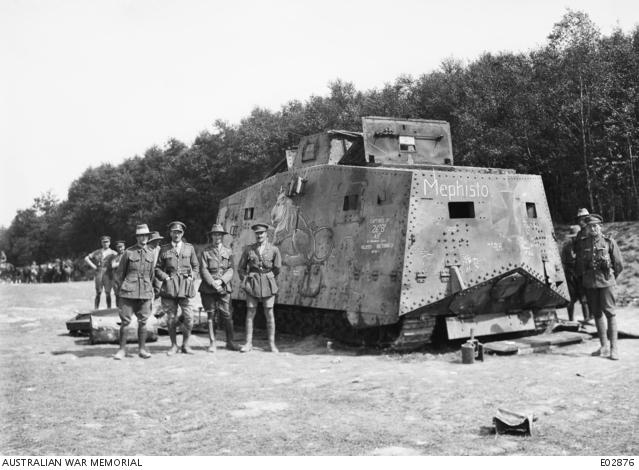
At the 5th Tank Brigade demonstration ground, Vaux-en-Amienois, France, Australian soldiers inspect Mephisto, a German A7V tank.
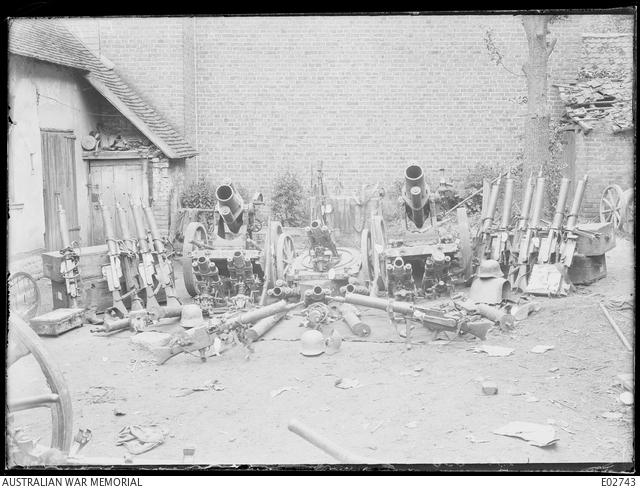
Trophies captured by the Australian troops during the battle of Hamel, at the Australian War Records Section Collecting Depot at Ailly-sur-Somme.
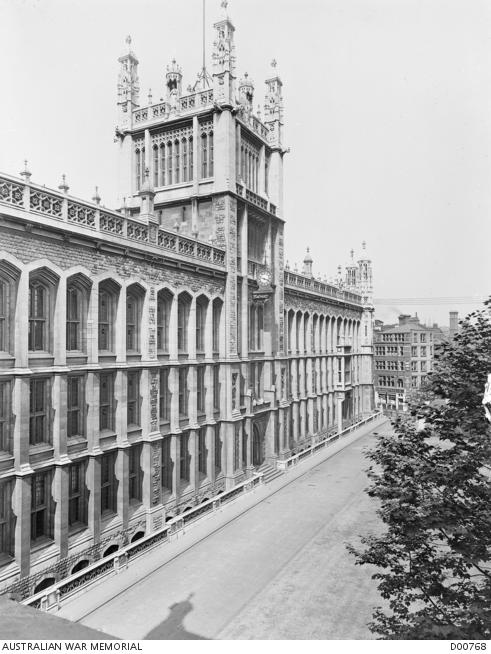
The Public Record Office, Chancery Lane, London. In this building the Australian War Records Section was formed in May 1917 and it continued to occupy rooms here until March 1919.
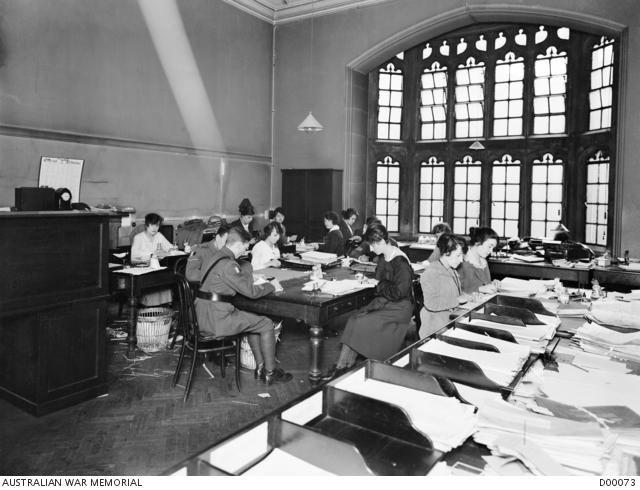
The staff, engaged in completing the war diaries for the British Government at work in one of the section's rooms at the Public Records Office, Chancery Lane.
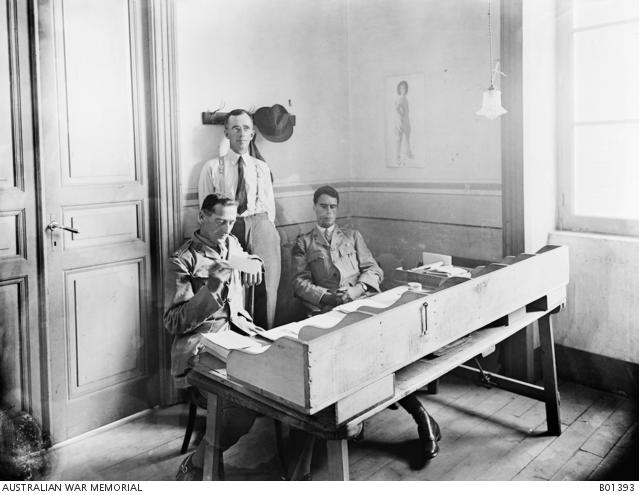
Members of the War Records Section in the office.
From left to right: Lieutenant Murray, Official Surveyor; Mr Gullett, Official War Correspondent; Lieutenant O'Connor, Photographic Officer.
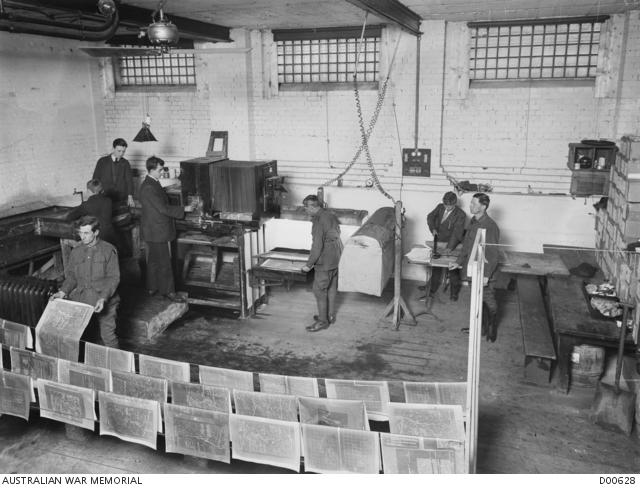
London, England. June 1919.
Photostat Room of the Australian War Records Section with maps hanging over a line to dry.
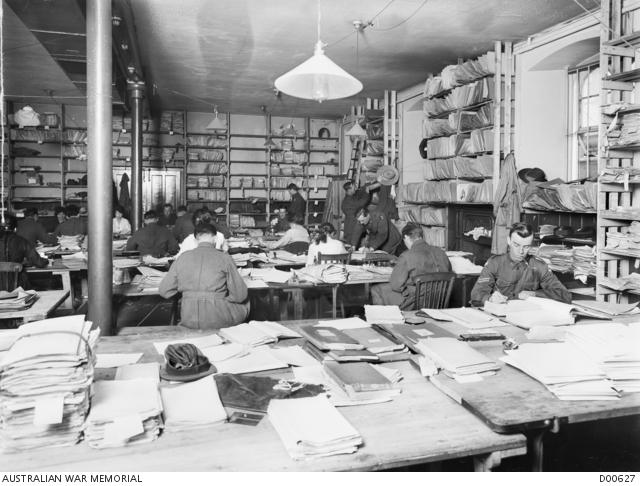
London, England. June 1919.
Photostat Room of the Australian War Records Section with maps hanging over a line to dry.
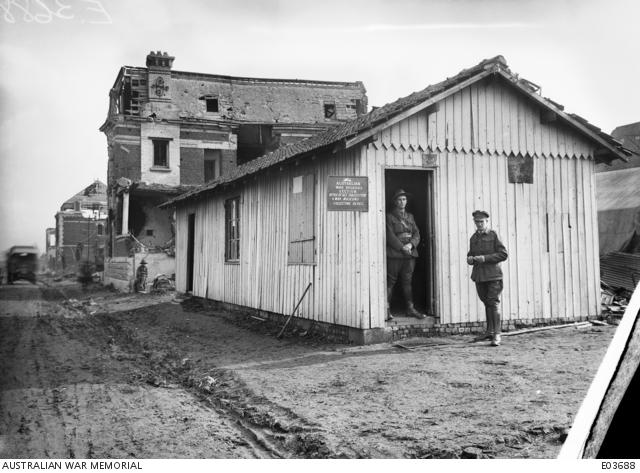
The Office of No. 2 British Expeditionary Force (BEF) subsection of the Australian War Records Section in Peronne during September 1918 and October 1918 with Lieutenant W. W Anderson, Museum Officer, in front, and Lieutenant Sidney W Gullett, Officer in Charge, in the doorway.

The trophies store of the Australian War Records Section at Millwall Dock, to which captured equipment collected by AIF units and personnel in France, and the United Kingdom were forwarded. They were here checked, and carefully packed, ready for despatch to Australia. A consignment is opened up ready for checking and final packing.
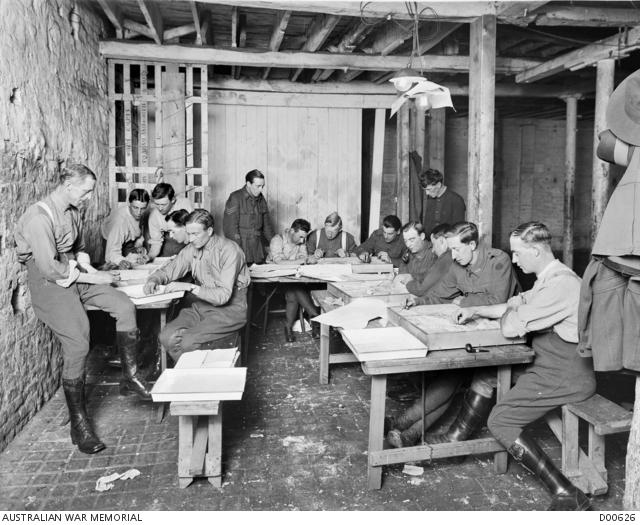
Modelling Subsection of the Australian War Records Section. Staff are engaged in the preliminary work for the modelling of battlefield.
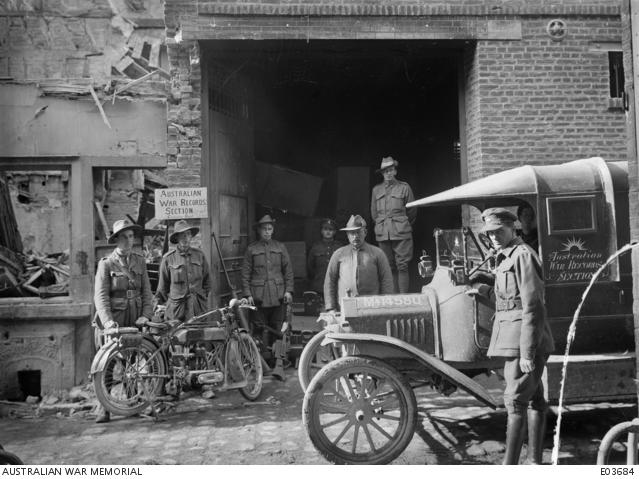
The Australian War Records Section (AWRS) Trophy Store at Peronne, where battle souvenirs were collected for despatch to the Australian War Museum.
FURTHER INFORMATION
Books
Shaune Lakin, Contact: photographs from the Australian War Memorial collection (Canberra: Australian War Memorial, 2006). [Includes a chapter covering photographic work of the AWRS.]
Michael McKernan, Here is their spirit: a history of the Australian War Memorial 1917-1990 (Canberra & St Lucia, Queensland: Australian War Memorial & University of Queensland Press, 1991). [Includes a chapter that substantially covers the work of the AWRS.]
Articles
Charles Bean, ‘Australia’s records: preserved as sacred things: pictures, relics, writings’, The Anzac Bulletin, Vol 40, 10 October 1917, pp. 14-15.
Anne-Marie Condé, ‘Caring for the past’, Wartime, Vol 32, 2005, pp. 40-43.
Anne-Marie Condé, ‘Imagining a collection: creating Australia’s records of war’, reCollections: The Journal of the National Museum of Australia, Vol. 2, Number 1, March 2007.
Anne-Marie Condé, ‘War history on scraps of paper’: exhibitions of documents at the Australian War Memorial, 1922-1954, Public History Review, Volume 14, 2007 (forthcoming). [Includes a section on the AWRS and Bean and Treloar’s ideas about collecting and exhibiting the collection.]
Michael Piggott, ‘The Australian War Records Section and its aftermath, 1917-1925’, Archives and Manuscripts, Vol. 8, No. 2, December 1980, pp. 41-50. [Mainly about archives. This is the first serious published treatment of the work of the AWRS.]
Ann Millar, ‘Gallipoli to Melbourne: the Australian War Memorial 1915-1919’, Journal of the Australian War Memorial, Vol 10, April 1987, pp. 33-42. [General]
Simon Cooke and Anna Froude, ‘The Australian War Records Section’, [paper presented as part of the Australian War Memorial’s Summer Scholarship Scheme, 1989]. [Probably the best general treatment, but should be read in conjunction with McKernan].
Peter Stanley, ‘Ernie Bailey: “founder” of the Australian War Museum’, Wartime, Vol 28, pp 34-35. [Bailey worked for the AWRS and died in an accident while on duty]
Unpublished sources
John Treloar, ‘Report on the work of the Australian War Records Section from May 1917 to September 1918 by the Officer-in-Charge,’ AWM224, MSS553 Part 1.
Charles Bean, ‘The Australian war records: an account of the present development overseas and suggestions of course necessary to be taken at the end of the war’, AWM38, 3DRL 6673/362.
Charles Bean, ‘Further memoir, together with appendices, by C.E.W. Bean, official historian, Australian Imperial Force, concerning the official records and history of the Australian Imperial Force and the establishment of the Memorial’, AWM93, 2/5/7.
Charles Bean, ‘The Beginnings of the Australian War Memorial’, AWM38, 3DRL 6673/619.
Bruce Harding, ‘Official primary sources in the Library of the Australian War Memorial’, March 1973, AWM315, 535/002/001.
John Treloar, ‘Australia’s war records: how they were collected, what will be done with them’, [draft of an article for Life magazine], AWM93, 20/1192.
Visit our donations page to find out more information on donating records.
Originally published Tuesday 12 June 2007 by Anne-Marie Conde.